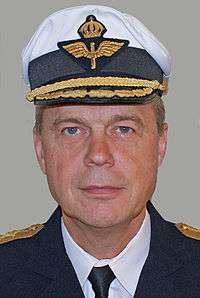Anders Silwer
Lieutenant General Anders Tommy Silwer (born 20 January 1959) is a retired Swedish Air Force officer. His last position was as the Chief of Training and Development (Produktionschef) from 2014 to 2017.
Anders Silwer | |
|---|---|
 | |
| Birth name | Anders Tommy Silwer |
| Born | 20 January 1959 Båstad, Sweden |
| Allegiance | Sweden |
| Service/ | Swedish Air Force |
| Years of service | 1979–2017 |
| Rank | Lieutenant General |
| Commands held | Inspector of the Air Force Air Component Command Chief of Operations Chief of Training and Development |
Career
Silwer was born in Båstad, Sweden[1] and grew up in the countryside of northwest Scania. His interest in flying came at an age of 10 when his cousin brought him along in a private aircraft. Silwer then joined the local shooting association.[2] In the beginning of Silwer's military career he was an Instructor Ground Defence at the Scania Air Force Wing (F 10) from 1979 to 1981 and from 1985 he served as an Interceptor Pilot of Saab 35 Draken at the Scania Air Force Wing until 1989. He flew Saab 35 Draken, Saab JAS 39 Gripen and Saab 105 totaling 2200 flight hours. Silwer was a Qualified Flying Instructor for Saab 35 Draken at the Scania Air Force Wing from 1990 to 1992[1] and underwent the Royal Australian Air Force's Basic Staff Course at RAAF College in Point Cook, Australia in the spring of 1992.[3] Back in Sweden, Silwer completed the Staff Course at the National Defence College in Stockholm from 1992 and 1993.[1]
He was acting commanding officer of the 103 Fighter Squadron at the Scania Air Force Wing from 1993 to 1994 and commanding officer of the 102 Fighter Squadron at the Scania Air Force Wing from 1994 to 1995. Silwer completed the Command and General Staff Course at the Swedish National Defence College in Stockholm from 1995 to 1997 and was commanding officer of the Operational Test and Evaluation Unit Gripen at the Skaraborg Air Force Wing (F 7) from 1998 to 2000. He completed a Master in Strategic studies at the Air War College, Air University in United States from 2000 to 2001.[1] Silwer was then the Chief of Staff Operations at the Air Force Tactical Command in Uppsala from 2001 to 2002 and the Deputy Air Component Commander at the Air Force Command in Uppsala from 2003 to 2004.
Silwer was then the head of the Strategic Short Term Planning, Strategic Plans and Policy at the Swedish Armed Forces Headquarters from 2004 to 2005 and the commander of the Joint Forces Air Component Command at the Swedish Joint Forces Command (Insatsstaben) in Uppsala from 2006 to 2007. He was the deputy commander of the Air Component Command at the Swedish Joint Forces Command in Stockholm from 2007 to 2008 and was the Inspector of the Air Force and commander of the Air Component Command from 2008 to 2011. Silwer was then the Chief of Operations (Insatschef) of the Joint Forces Command from 2012 to 2013[1] before being appointed Chief of Training and Development (Produktionschef) of the Swedish Armed Forces Training & Development Staff (Produktionsledningen) in 2014.[4] He retired in March 2017.[5]
Other work
Silwer became a member of the Royal Swedish Academy of War Sciences in 2000 and a member of the International Hall of Fame at the United States Air University in 2001.[1] He was a board member of the Swedish Defence University from 1 May 2016 to 30 April 2017.[6]
Personal life
Silwer lived on Lidingö.[2] He is married and has three children.[1] His surname, Silwer, comes from a fältskär who lived in Silvåkra which today belongs to the training grounds of South Scanian Regiment (P 7).[2]
Dates of rank
- 1979 - Överfurir
- 1981 - Sergeant
- 1983 - Lieutenant
- 1989 - Captain
- 1993 - Major
- 1998 - Lieutenant Colonel
- 2001 - Colonel
- 2006 - Brigadier General
- 2008 - Major General
- 2012 - Lieutenant General
Awards and decorations
Silwer's awards:[1]
- For Zealous and Devoted Service of the Realm
- Swedish Armed Forces Conscript Medal
- National Union of Air Force Associations Badge of Merit (Flygvapenföreningarnas riksförbunds förtjänsttecken)
- Air Defence Regiment Medal of Merit (Luftvärnsregementets förtjänstmedalj)
- Union of Swedish Reserve officers Badge of Merit (Förbundet Sveriges Reservofficerares förtjänsttecken)
References
| Wikimedia Commons has media related to Anders Silwer. |
- "Curriculum vitae" (PDF). Swedish Armed Forces. 1 January 2012. pp. 1–2. Archived from the original (PDF) on 2015-09-26. Retrieved 29 November 2016.
- "Ny insatschef" [New Director of Operations] (in Swedish). Swedish Armed Forces. 15 December 2011. Retrieved 29 November 2016.
- Nilsson, Kjell (1993). "På andra sidan jorden - Australiens flygvapen" [On the other side of the globe - Australia's air force] (PDF). Flygvapennytt (in Swedish). Stockholm: Flygstaben (1): 25. SELIBR 8257600.
- "Chefsbyte i Högkvarteret" [Change of chiefs at the Headquarters] (in Swedish). Swedish Armed Forces. 8 January 2014. Retrieved 2 December 2016.
- "Johan Svensson ny produktionschef" [Johan Svensson new Chief of Training and Development] (in Swedish). Swedish Armed Forces. 14 December 2016. Retrieved 14 January 2017.
- "Styrelse" [Board] (in Swedish). Swedish Defence University. 2016-11-15. Retrieved 2 December 2016.
| Military offices | ||
|---|---|---|
| Preceded by Jan Andersson |
Inspector of the Air Force 2008–2011 |
Succeeded by Micael Bydén |
| Preceded by Jan Andersson |
Air Component Command 2008–2011 |
Succeeded by Micael Bydén |
| Preceded by Anders Lindström |
Chief of Operations (Insatschef) 2012–2013 |
Succeeded by Göran Mårtensson |
| Preceded by Göran Mårtensson |
Chief of Training and Development (Produktionschef) 2014–2017 |
Succeeded by Johan Svensson |